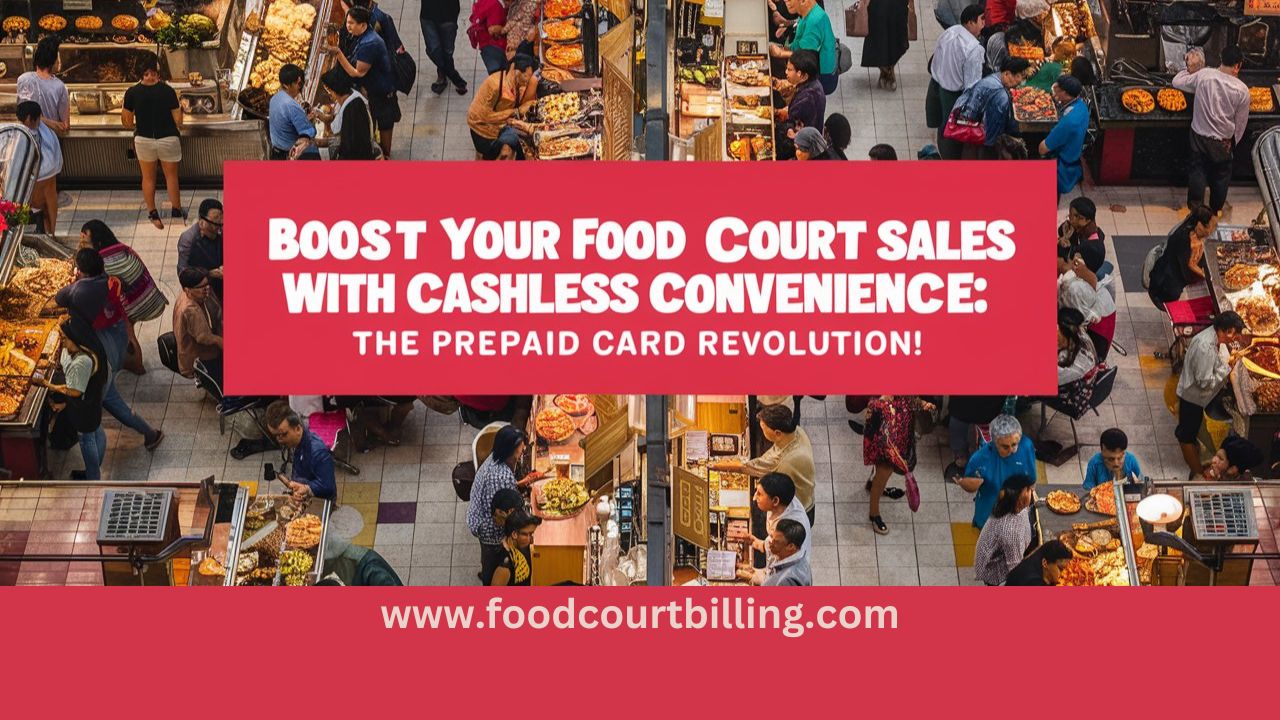Boost your food court sales with the convenience of prepaid cards. Discover how cashless transactions can enhance customer experience, streamline operations, and increase revenue. Learn key implementation strategies and real-world success stories. Embrace the prepaid card revolution today!
In the rapidly evolving world of retail and dining, staying ahead of the competition requires constant innovation and adaptation to new consumer preferences. One significant trend reshaping the food and beverage industry is the shift towards cashless transactions. As food courts compete for customer loyalty and increased sales, adopting a prepaid card system presents a unique opportunity to enhance customer convenience, streamline operations, and ultimately boost sales. In this blog, we’ll explore how the prepaid card revolution is transforming food courts and why it’s a strategic move for your business.
The Rise of Cashless Transactions
In recent years, the global shift towards cashless transactions has been driven by several factors:
- Technological Advancements: The proliferation of smartphones and mobile payment platforms has made cashless transactions more accessible and convenient for consumers.
- Consumer Preferences: Modern consumers, especially younger generations, prefer the speed and ease of cashless payments.
- Health and Safety: The COVID-19 pandemic accelerated the adoption of contactless payments, highlighting the importance of minimizing physical contact.
Given these trends, food courts that embrace cashless payment solutions are well-positioned to meet the evolving demands of their customers.
What Are Prepaid Cards?
Prepaid cards are a form of cashless payment where customers load a specific amount of money onto a card, which they can then use to make purchases within the food court. These cards can be physical or digital and offer a range of benefits for both consumers and businesses.
Benefits of Prepaid Cards for Food Courts
1. Enhanced Customer Convenience
Prepaid cards simplify the payment process for customers. Instead of carrying cash or multiple credit cards, they can use a single prepaid card to make purchases at various food court vendors. This ease of use can significantly enhance the customer experience, encouraging repeat visits.
2. Faster Transactions
Cashless transactions are typically faster than cash payments. This speed not only reduces waiting times for customers but also increases the number of transactions that can be processed during peak hours, boosting overall sales.
3. Increased Customer Loyalty
Prepaid cards can be integrated with loyalty programs, offering customers rewards and incentives for repeated use. This integration fosters customer loyalty and encourages more frequent visits to the food court.
4. Streamlined Operations
For food court vendors, prepaid cards simplify cash management by reducing the need for cash handling and the associated risks of theft or loss. Additionally, they provide a clear record of transactions, aiding in accurate sales tracking and financial reporting.
5. Valuable Data Insights
Prepaid card systems can capture detailed data on customer spending habits and preferences. This information can be invaluable for food court operators, enabling them to tailor marketing strategies, optimize inventory, and identify popular products.
6. Increased Sales
With the convenience and incentives offered by prepaid cards, customers are likely to spend more. The ease of use and integration with loyalty programs can drive higher sales volumes and increased average transaction values.
Implementing a Prepaid Card System
Implementing a prepaid card system in your food court involves several key steps:
1. Choose the Right Technology
Selecting the right technology provider is crucial. Look for a provider that offers robust, secure, and user-friendly solutions. Key features to consider include compatibility with existing point-of-sale (POS) systems, support for both physical and digital cards, and integration with loyalty programs.
2. Design and Branding
Design your prepaid cards to reflect your food court’s brand. Eye-catching designs can make the cards more appealing to customers. Additionally, consider offering customizable card designs for corporate clients or special events.
3. Launch a Marketing Campaign
Promote the new prepaid card system through a comprehensive marketing campaign. Use social media, email newsletters, in-store signage, and promotional events to raise awareness and encourage customers to adopt the new payment method.
4. Train Staff
Ensure that your staff is well-trained on how to process prepaid card transactions and assist customers with any questions. This training will help ensure a smooth transition to the new system and enhance the overall customer experience.
5. Monitor and Optimize
After launching the prepaid card system, continuously monitor its performance. Gather feedback from customers and staff to identify any issues or areas for improvement. Use data analytics to track usage patterns and adjust your marketing and operational strategies accordingly.
Case Studies: Success Stories
The Mall Food Court
A large mall food court implemented a prepaid card system to streamline operations and enhance customer experience. The food court integrated the cards with a loyalty program, offering customers points for every purchase made with the prepaid card. Within six months, the food court saw a 20% increase in sales and a significant boost in customer satisfaction.
The University Campus
A university campus food court adopted a digital prepaid card system, allowing students to load funds onto their student ID cards. The system provided a convenient and cashless way for students to make purchases. As a result, the food court experienced a 15% increase in transaction volumes and reduced cash handling costs.
Overcoming Challenges
While the benefits of prepaid card systems are clear, there are also challenges to consider:
1. Initial Setup Costs
Implementing a prepaid card system involves initial setup costs, including purchasing hardware, software, and card inventory. However, the long-term benefits often outweigh these initial investments.
2. Customer Adoption
Encouraging customers to switch from cash or traditional payment methods to prepaid cards can be challenging. Effective marketing and customer education are crucial to overcoming this hurdle.
3. Security Concerns
Ensuring the security of prepaid card transactions is vital. Choose a technology provider with robust security measures, including encryption and fraud detection, to protect customer data and transactions.
The Future of Cashless Convenience
The trend towards cashless transactions is expected to continue growing. As technology advances and consumer preferences evolve, food courts that embrace innovative payment solutions like prepaid cards will be better positioned to thrive in the competitive landscape. The key to success lies in understanding and meeting customer needs, streamlining operations, and leveraging data to make informed business decisions.
Conclusion
The prepaid card revolution offers a unique opportunity for food courts to enhance customer convenience, streamline operations, and boost sales. By adopting a prepaid card system, food court operators can stay ahead of the competition and create a more engaging and efficient dining experience for their customers. As the world moves towards a cashless future, embracing these innovations will be crucial for sustained growth and success in the food and beverage industry.
By implementing the strategies outlined in this blog, you can take advantage of the prepaid card revolution and position your food court for increased sales and customer loyalty. Embrace the future of cashless convenience and watch your business thrive!
We hope you enjoyed reading our blog posts about food court billing solutions. If you want to learn more about how we can help you manage your food court business, please visit our website here. We are always happy to hear from you and answer any questions you may have. You can reach us by phone at +91 9810078010 or by email at ats.fnb@gmail.com. Thank you for your interest in our services.
www.foodcourtbilling.com
FAQ
1. What are the main benefits of using prepaid cards in a food court?
Answer: Prepaid cards offer several benefits, including enhanced customer convenience, faster transactions, increased customer loyalty through integrated rewards programs, streamlined cash management, valuable data insights on customer spending habits, and the potential for increased sales.
2. How can prepaid cards improve customer experience in a food court?
Answer: Prepaid cards simplify the payment process, allowing customers to use a single card for multiple vendors within the food court. This ease of use reduces wait times and enhances the overall dining experience, making customers more likely to return.
3. What are the initial steps to implement a prepaid card system in a food court?
Answer: To implement a prepaid card system, start by selecting the right technology provider that offers secure and user-friendly solutions. Design and brand the cards to reflect your food court’s identity, launch a marketing campaign to promote the new system, train staff on the new process, and continuously monitor and optimize the system based on customer feedback and usage data.
4. How do prepaid cards help in streamlining operations for food court vendors?
Answer: Prepaid cards reduce the need for cash handling, minimizing the risks of theft and loss. They also provide a clear record of transactions, making sales tracking and financial reporting more accurate. This streamlined cash management allows vendors to focus more on service and less on administrative tasks.
5. What are some potential challenges in adopting a prepaid card system, and how can they be addressed?
Answer: Challenges include initial setup costs, encouraging customer adoption, and ensuring transaction security. These can be addressed by investing in a reliable technology provider, conducting effective marketing and customer education campaigns, and implementing robust security measures such as encryption and fraud detection.




